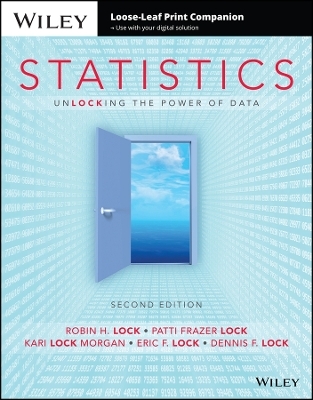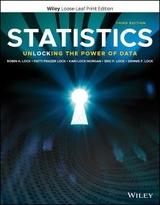
Statistics
John Wiley & Sons Inc (Verlag)
978-1-119-16366-4 (ISBN)
- Titel erscheint in neuer Auflage
- Artikel merken
Robin H. Lock is Burry Professor of Statistics in the Department of Mathematics, Computer Science, and Statistics at St. Lawrence University. He is a Fellow of the American Statistical Association, past Chair of the Joint MAA-ASA Committee on Teaching Statistics, a member of the committee that developed GAISE (Guidelines for Assessment and Instruction in Statistics Education), and a member of the Consortium for the Advancement of Undergraduate Statistics Education, CAUSE. His work was recognized with the ASA's inaugural Waller Distinguished Teaching Career Awared in 2014 and he has won numerous other awards for presentations on statistics education at national conferences. He brings to the project an insider's understanding of national trends in statistics education. Patti Frazer Lock is Cummings Professor of Mathematics at St. Lawrence University. She is a member of the Committee on the Undergraduate Program in Mathematics of the Mathematics Association of America, and chairs the MAA subcommittee writing the guidelines for the future of Intro Stats courses. She won the J. Calvin Keene faculty award at St. Lawrence University. She is a member of the Calculus Consortium and is a co-author on Hughes-Hallett's Calculus and Applied Calculus, Connally's Functions Modeling Change, and McCallum's Algebra and Multivariable Calculus texts. She is passionate about helping students succeed in, and enjoy, introductory courses in statistics and mathematics. She feels very lucky to be writing this book with her family! Kari Lock Morgan is now an assistant professor in the Statistics Department at Penn State University after finishing her Ph. D. in Statistics at Harvard University and spending three years teaching at Duke University. She has taught a variety of statistics classes, including a special course for graduate students on "The Art and Practice of Teaching Statistics", and helped co-develop a new 100-level course at Harvard designed to make statistics enjoyable and applicable to real life. She won the Derek C. Bok Award for Excellence in the Teaching of Undergraduates. She has a particular interest in causal inference, statistics education, and applications of statistics in psychology, education, and health. Eric F. Lock is an assistant professor of Biostatistics at the University of Minnesota School of Public Health. He received his Ph.D. in Statistics from the University of North Carolina in 2012, and spent two years doing a post doc in statistical genetics at Duke University. He has been an instructor and instructional assistant for multiple introductory statistics courses, ranging from very traditional to more progressive. He has a particular interest in machine learning and the analysis of high-dimensional data, and has conducted research on applications of statistics in genetics and medicine. Dennis F. Lock recently followed his interests in sports statistics to become the Director of Analytics for the Miami Dolphins (football team). He finished his Ph.D. focusing on sports statistics with the Department of Statistics at Iowa State University where he served as a statistical consultant for several years and received the Dan Mowrey Consulting Excellence Award. In 2014 he helped design and implement a randomized study at Iowa State to compare the effectiveness of randomization and traditional approaches to teaching introductory statistics.
Preface ix
Unit A: Data 1
Chapter 1. Collecting Data 2
1.1. The Structure of Data 4
1.2. Sampling from a Population 16
1.3. Experiments and Observational Studies 29
Chapter 2. Describing Data 46
2.1. Categorical Variables 48
2.2. One Quantitative Variable: Shape and Center 63
2.3. One Quantitative Variable: Measures of Spread 77
2.4. Boxplots and Quantitative/Categorical Relationships 93
2.5. Two Quantitative Variables: Scatterplot and Correlation 106
2.6. Two Quantitative Variables: Linear Regression 123
2.7. Data Visualization and Multiple Variables 137
Unit A: Essential Synthesis 161
Review Exercises 174
Unit B: Understanding Inference 193
Chapter 3. Confidence Intervals 194
3.1. Sampling Distributions 196
3.2. Understanding and Interpreting Confidence Intervals 213
3.3. Constructing Bootstrap Confidence Intervals 228
3.4. Bootstrap Confidence Intervals using Percentiles 242
Chapter 4. Hypothesis Tests 256
4.1. Introducing Hypothesis Tests 258
4.2. Measuring Evidence with P-values 272
4.3. Determining Statistical Significance 288
4.4. A Closer Look at Testing 303
4.5. Making Connections 318
Unit B: Essential Synthesis 341
Review Exercises 351
Unit C: Inference with Normal and t-Distributions 369
Chapter 5. Approximating with a Distribution 370
5.1. Hypothesis Tests Using Normal Distributions 372
5.2. Confidence Intervals Using Normal Distributions 387
Chapter 6. Inference for Means and Proportions 402
6.1. Inference for a Proportion
6.1-D Distribution of a Proportion 404
6.1-CI Confidence Interval for a Proportion 407
6.1-HT Hypothesis Test for a Proportion 414
6.2. Inference for a Mean
6.2-D Distribution of a Mean 419
6.2-CI Confidence Interval for a Mean 424
6.2-HT Hypothesis Test for a Mean 433
6.3. Inference for a Difference in Proportions
6.3-D Distribution of a Difference in Proportions 438
6.3-CI Confidence Interval for a Difference in Proportions 441
6.3-HT Hypothesis Test for a Difference in Proportions 446
6.4. Inference for a Difference in Means
6.4-D Distribution of a Difference in Means 452
6.4-CI Confidence Interval for a Difference in Means 455
6.4-HT Hypothesis Test for a Difference in Means 461
6.5. Paired Difference in Means 468
Unit C: Essential Synthesis 477
Review Exercises 489
Unit D: Inference for Multiple Parameters 505
Chapter 7. Chi-Square Tests for Categorical Variables 506
7.1. Testing Goodness-of-Fit for a Single Categorical Variable 508
7.2. Testing for an Association between Two Categorical Variables 523
Chapter 8. ANOVA to Compare Means 538
8.1. Analysis of Variance 540
8.2. Pairwise Comparisons and Inference after ANOVA 563
Chapter 9. Inference for Regression 574
9.1. Inference for Slope and Correlation 576
9.2. ANOVA for Regression 591
9.3. Confidence and Prediction Intervals 603
Chapter 10. Multiple Regression 610
10.1. Multiple Predictors 612
10.2. Checking Conditions for a Regression Model 624
10.3. Using Multiple Regression 633
Unit D: Essential Synthesis 647
Review Exercises 661
The Big Picture: Essential Synthesis 669
Exercises for the Big Picture: Essential Synthesis 683
Chapter P. Probability Basics 688
P.1. Probability Rules 690
P.2. Tree Diagrams and Bayes’ Rule 702
P.3. Random Variables and Probability Functions 709
P.4. Binomial Probabilities 716
P.5. Density Curves and the Normal Distribution 724
Appendix A. Chapter Summaries 737
Appendix B. Selected Dataset Descriptions 749
Partial Answers 761
Index
General Index 783
Data Index 786
| Erscheinungsdatum | 21.09.2017 |
|---|---|
| Verlagsort | New York |
| Sprache | englisch |
| Maße | 213 x 274 mm |
| Gewicht | 1406 g |
| Themenwelt | Mathematik / Informatik ► Mathematik ► Statistik |
| ISBN-10 | 1-119-16366-8 / 1119163668 |
| ISBN-13 | 978-1-119-16366-4 / 9781119163664 |
| Zustand | Neuware |
| Informationen gemäß Produktsicherheitsverordnung (GPSR) | |
| Haben Sie eine Frage zum Produkt? |
